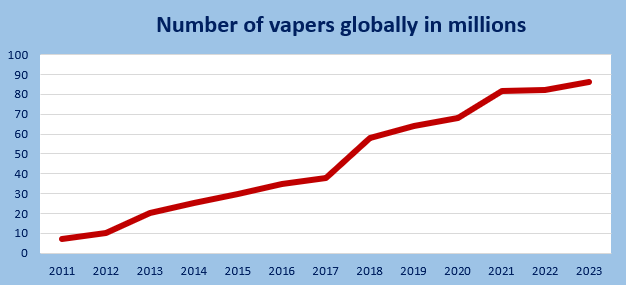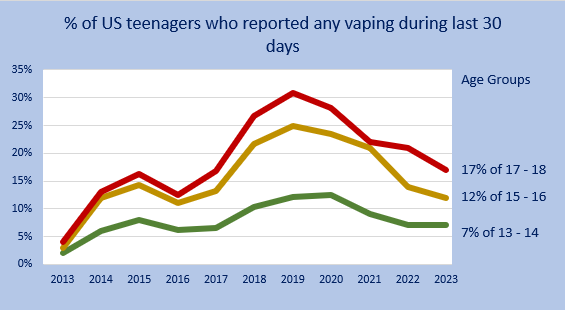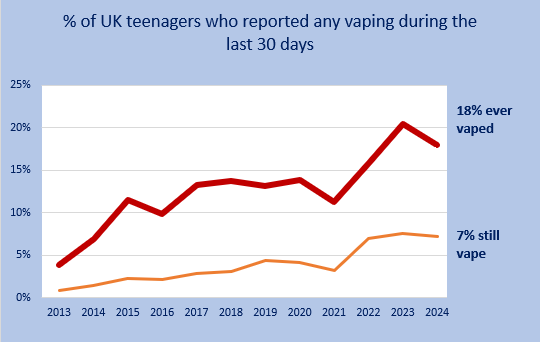Vaping & E-cigarettes: Facts & Statistics
Learn about the difference between vaping and e-cigarettes usage, including the latest facts and statistics to help you to quit for good. Read here.

What’s stopping you quit vaping?
Not sure if you’re ready to stop vaping? Worried about finding it difficult?
Start quizThe idea of electronic cigarettes has been around since a patent was granted in the US for such a device in 1930. However, it was not until 2003 that the first commercial device was created in Beijing by a pharmacist.
Since that date more products have been created, from vaping to heat not burn devices, encouraging people to move from traditional tobacco products to the new “safer” devices as well as encouraging people to use them who do not smoke. These are now often called Electronic Nicotine Delivery Systems (ENDS) and Electronic Non-Nicotine Delivery Systems (ENNDS).
How popular is vaping?
Global vaping or e-cigarette use and sales have risen dramatically since 20111.
Number of global vapers in millions
Source: Euromonitor International / BBC / GSTHR1
A few quick facts
- In 2023, 12% of US 13-14 year olds had vaped nicotine, in 2016 it was only 3.5%
- In 2022 21% of UK 11 – 17 year olds had vaped (11% in 2021) and 38% of 18 years old had vaped (30% in 2021); in 2013 only 5% of 11-17 year olds had vaped17
- Even nicotine free juice often contains nicotine30
- Vapers often uptake more nicotine that smokers31
- The global e-cigarette and vape market was valued at US$22.8bn in 2022 compared with $3bn in 2016 and expected to grow to US$28bn by 20263
Vaping statistics worldwide
Vaping statistics worldwide
A few quick facts
- Vape liquid or juice contains up to 80 chemicals including nicotine, cancer-causing chemicals and toxic heavy metals such as nickel, tin and lead7
- In US more young people than adults vape7 – Read more teen vaping statistics and facts
- In 2019 9% of 13-14 year olds had vaped nicotine; in 2017 it was only 3.5%4
- Only 40% of parents were aware that their children vaped; against 70% for smoking9
- Around two-thirds of JUUL users aged 15-24 do not know that JUUL contains nicotine5
- The nicotine content of one JUUL pod is equivalent to one pack of cigarettes6.
- In 2016 nearly 200 e-cigarette users developed severe lung disease in 22 states across USA Read more about vaping damage to lungs
Top 5 markets for vape products 2020 ($m)
Source: Statista3
Vaping statistics in the UK
UK vaping or e-cigarette use and sales have risen dramatically since 2012.
Number of UK vapers in millions
Source: ASH2 & 26
A few quick facts
- The UK is the second largest market in the world for vape products worth £2.3bn in 20203
- The age range with the most UK vapers is 35-44 years olds2(in the US it is 18-24 year olds)
- The most common reason for vaping in the UK is as an aid to quitting smoking (30%)26
- 50% of vapers use refillable tanks down from 77% in 202126
- 31% now use disposable vapes (2% in 2021) particularly younger adults26
- In 2023, over 9.1% of the GB population were using e-cigarettes a large increase year on year26
- In 2020 18-24 year old had the lowest vaping rate but in 2022 they had the highest26.
- The most popular flavour vape juice is fruit26 at 47%
- The most popular flavour in 2015 was tobacco at 38%3 (2023 – 12%26)
Vaping statistics in the US
US vaping or e-cigarette use and sales have risen dramatically since 2012. The graph below shows the growth in teens:
Number of US vapers in millions
Source: CDC39
A few quick facts
- The US is the largest market in the world for vape products worth US$6.2bn in 20203
- 9% of US adults vape regularly or occasionally14
- Oklahoma has the highest rate of e-cigarette usage, followed by Louisiana, Nevada, Ohio, Tennessee, and Kentucky5
- Washington, D.C. has the lowest rate of e-cigarette usage, followed by South Dakota, California, Maryland, and Vermont5
- The age range with the most US vapers is 18-29 years olds14
- 73% of vapers use JUUL19
- The most popular flavour vape juice is fruit15
- The main reason for vaping is young people being attracted to the flavours and advertising (22%)7, 16
Vaping statistics by age
Vaping statistics vary by country due to the policies and controls in place by the various governments.
Age Profile of US Vapers who vaped in the last week
Source: Gallop 8
The graphs show clearly that in the US most vapers are young people whereas in the UK it is more evenly distributed but with youth vaping on the increase. The reason for the difference is the strong push in the UK by the authorities to promote vaping as a means of stopping smoking and restrictions on advertising and marketing of vaping.
Health risks exist for vaping and more research is on-going into this area. In the US the authorities make it clear that vaping is not harmless and can contain harmful and potentially harmful substances5.
% of US teenagers who reported any vaping during the last 30 days
Source: University of Michigan Monitoring the Future survey4 & 27
There has clearly been a rapid increase in the number of teens vaping. The marketing aimed to encourage them to start vaping coupled with flavours that appeal to them has lead to this increase. Most teens are unaware that electronic cigarettes contain nicotine9 or of the health dangers they pose. For more information about teen vaping click the button below:
Is vaping safe? – 5 Vaping health facts you should know:
1. Vaping is less harmful than smoking but it’s still not safe
It is likely that vaping is less harmful than smoking but it is definitely not harmless. Some people have compared vaping instead of smoking as being like falling from the 10th floor of a building rather than the 20th floor. There is some integrity to this comparison although it’s not a simple consideration.
The World Health Organisation13 has also cited many concerns regarding vaping:
- The long-term effects are unknown but there is growing evidence of it’s harmful effects29
- Vaping liquid often contains nicotine even when it says it is nicotine free30.
- Nicotine is addictive
- There are many other questionable ingredients contained in the liquid
- There is no doubt that vaping causes lung issues, makes lungs more vulnerable to infection and disease, heart issues, weakens the immune system and more24, 29 & 33-35
In January 2018, the National Academies of Science, Engineering and Medicine released a consensus study report that reviewed over 800 different studies and concluded that ENDS /e-cigarettes / vaping causes health risks18.
2. Vaping is bad for your heart and lungs
The American Lung Association has stated that the inhalation of harmful chemicals [from vaping] can cause irreversible lung damage and lung disease24.
Vaping liquid contains over 80 chemicals including nicotine, cancer-causing chemicals and toxic heavy metals such as nickel, tin and lead7 all of which are associated with developing lung disease.
When heated the vaping liquid creates ultrafine particles and volatile organic compounds. These can exacerbate conditions such as asthma and emphysema and could lead to a heart attack11, 12.
Popcorn Lung – A chemical called diacetyl, which although banned in the UK & EU is available in juices worldwide including in US and online, is used to create a buttery flavour such as used in popcorn, custard and sweet dessert flavours. High levels of exposure to diacetyl can lead to the serious lung disease bronchiolitis obliterans also known as “popcorn lung”10.
EVALI/VAPI – E-cigarette Vaping product use Associated Long Injury (EVALI) is an acute or subacute respiratory illness with damage to the lungs that can be severe and life-threatening20, 21, 22. As of 18 February 2020 there were almost 3,000 hospitalised cases or deaths due to EVALI in US23 most of whom were under 35 years old.
Read full article – Can Vaping Damage the Lungs?
3. E-cigarettes are just as addictive as traditional cigarettes
E-cigarettes very often contain nicotine and even the juices that say they do not contain nicotine often do30. Furthermore, vaping is often a gateway to the nicotine variety and to smoking (the World Health Organisation estimates that for young people it more than doubles the likelihood of smoking in the future)29. In fact, 99% of the e-cigarettes sold in the USA contained nicotine5 and according to JUUL’s website the nicotine content of one JUUL pod is equivalent to one packet of cigarettes.
In fact e-cigarette users uptake of nicotine can be more than that of smoking because of the concentration of the juice, the power of the device, the ingredients in the juice and the puffing style of the user31. Furthermore, juice manufactures have developed new mixtures that deliver higher levels of nicotine to the user while masking it’s harshness enabling users to have more nicotine32.
Nicotine is a highly addictive substance and in fact it has been reported to be harder to quit than cocaine.
Vaping is therefore addictive due to nicotine just like cigarettes. Given that addicts are capable of increasing the dose of nicotine content – it is likely to be even more so.
Read full article – Is Vaping harder to quit than cigarettes?
4. E-cigarettes aren’t the best way to quit smoking
Vaping may be less harmful than smoking but it’s still not safe.
The US Surgeon General’s Report on Cessation concluded, “The evidence is inadequate to infer that e-cigarettes, in general, increase smoking cessation”36.
The European Union’s Scientific Committee on Health, Environmental and Emerging Risks (SCHEER) Opinion on electronic cigarettes concluded, “There is a lack of robust longitudinal data on the effect of electronic cigarettes on smoking cessation. Until such research is available, electronic cigarettes should only be considered to support smoking cessation for a limited time and under supervision” 37.
Furthermore, there is research that suggests that, in some cases, ENDS / vaping could hinder cessation in some individuals by prolonging or increasing addiction to nicotine38.
All the above has led the World Health Organisation to say “ENDS / vaping cannot be recommended as cessation aids” instead it recommends methods with randomised controlled trials that enable smokers to quit nicotine completely29. This is also the advice given by the US Centres for Disease Control and Prevention7.
The World Health Organisation goes on to say that “Randomized controlled trials show that there are proven ways for drug free smoking cessation, for example, intensive behavioural support with individual or group counselling [such as Allen Carr’s Easyway] is one of the effective interventions.”
Quitting nicotine completely may sound a daunting prospect but there is a drug free and clinically proven method called Allen Carr’s Easyway which, as it’s name says, is the easy way to quit nicotine completely.
Stop vaping with Allen Carr’s Easyway
5. A new generation is getting hooked on nicotine
In 2019, 9% of 13-14 year olds had vaped nicotine; in 2017 it was only 3.5%4. The rapid rise in young vapers is driven by the slick advertising projecting vaping as sexy, attractive and safe, (reminiscent of smoking adverts of a bygone era) and by the flavours that appeal to young people1. They also don’t realise there is nicotine in the vaping juice5. The use of the word “juice” is a deliberate choice on the part of the manufacturers – the implication is that the liquid is healthy rather than poisonous and addictive.
In addition a number of adults who have never smoked are now vaping, and smokers are combining vaping & smoking, drawn in by the same adverts in the belief that there is a health benefit from reducing their smoking, or that it is just a bit of fun with no harmful effects to vaping. However, vaping liquid contains over 80 chemicals including nicotine, cancer-causing chemicals and toxic heavy metals such as nickel, tin and lead7. When heated the vaping liquid creates ultrafine particles and volatile organic compounds. These can exacerbate conditions such as asthma and emphysema and could lead to a heart attack11, 12. Vaping is less harmful than smoking (but it’s still not safe).
It is worth noting that the single biggest factor to stop teens starting to vape appears to be to raise children in a smoke and vape free home. If the parents smoke or vape it normalises the behaviour in children who particularly when they are young look up to parents as their role models. This increases the likelihood that the child will be taken in by the advertising and go on to vape and smoke25.
In fact the World Health Organisation states that children who vape are more than twice as likely to start smoking28
The numbers, particularly amongst the young, show the risk that a new generation is getting hooked on nicotine.
Final Thoughts
The number of people using E-cigarettes has grown dramatically over the last few years many unaware that the vaping liquid contains harmful chemicals including nicotine.
The marketing makes it look sexy, fun and safe when the reality is that the products are addictive and can be damaging to health.
A new generation is now becoming addicted to nicotine.
A few useful vaping articles
Free Online Quiz
Not sure if you really want to quit vaping & smoking?
Need help to stop vaping?
Want to stop, but concerned that you’ll find it tough?
Worried that you’ll be deprived for the rest of your life without vapes & cigarettes?
We can help you to understand and remove those fears and in so doing, make it quitting easy.

FREE Videos & Information!
















